Discover 11 hidden attractions, cool sights, and unusual things to do in College Park (United States). Don't miss out on these must-see attractions: McKeldin Mall, Memorial Chapel, and Xfinity Center. Also, be sure to include Clarice Smith Performing Arts Center in your itinerary.
Below, you can find the list of the most amazing places you should visit in College Park (Maryland).
Table of Contents
McKeldin Mall
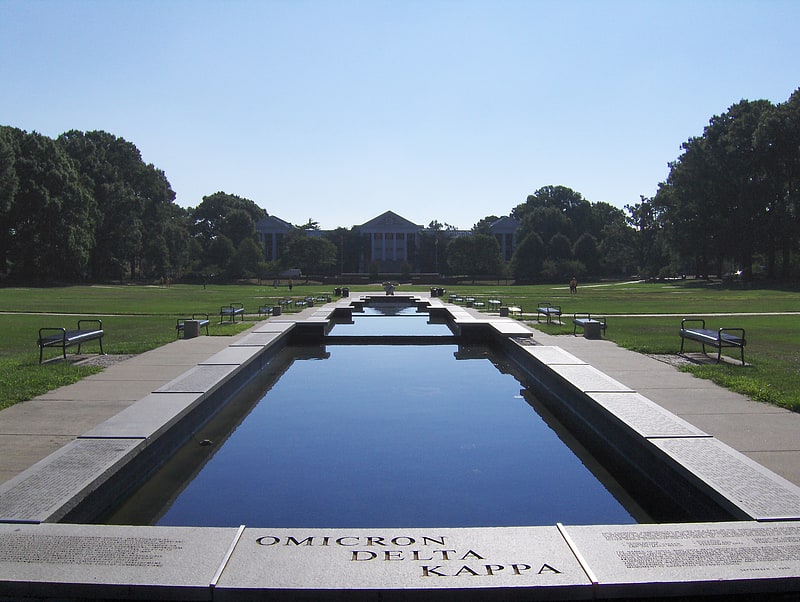
Park in College Park, Maryland. McKeldin Mall is a nine-acre quad in the heart of the campus of the University of Maryland, College Park. Named after Theodore McKeldin, the former Governor of Maryland, McKeldin Mall is the largest academic mall in the United States. It has been named one of the most picturesque college campus quads in the nation.[1]
Memorial Chapel

Memorial Chapel is a non-denominational building on the campus of the University of Maryland, College Park, constructed to honor those associated with the university who had lost their lives serving in the United States Armed Forces. The building, designed by Henry Powell Hopkins, actually is made up of three chapels: the Main Chapel, the West Chapel, and the Chapel of the Blessed Sacrament. A Vietnam Veterans Memorial was constructed on the Chapel grounds in 1988. The steeple of the chapel is the highest point on campus.[2]
Address: College Park, 7744 Regents Drive
Xfinity Center
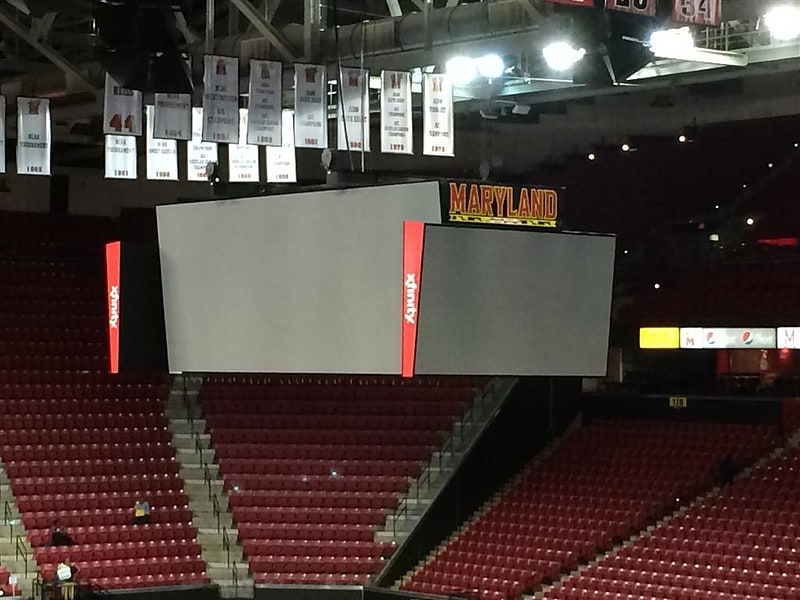
Arena in College Park, Maryland. Xfinity Center is the indoor arena and student activities center that serves as the home of the University of Maryland Terrapins men's and women's basketball teams. Ground was broken in May 2000 and construction was completed in October 2002 at a cost of $125 million. It replaced Cole Field House as the Terrapins' home court, which had served as the home of Maryland basketball since 1955.
The on-campus facility was originally named the Comcast Center after Comcast Corporation purchased a 20-year, $25 million corporate naming agreement when the arena opened in 2002. In July 2014, it was renamed Xfinity Center after Comcast's cable brand, Xfinity.
Xfinity Center, which has a capacity of 17,950, opened for Midnight Madness on October 11, 2002, and the first official men's game was a 64–49 victory over Miami University (Ohio) on November 24, 2002. In its first season, 281,057 fans visited to watch Terrapin basketball games for a per-game average of 17,566 as Maryland finished fifth in the nation in attendance. On January 25, 2012, the court was renamed in honor of Gary Williams, the men's basketball coach who retired the previous year.
Though Xfinity Center is the largest arena in the state of Maryland, it is the second-largest arena in the Washington, D.C. metropolitan area by seating capacity, just behind Capital One Arena in Washington, D.C., which has an official seating capacity of roughly 500 more than Xfinity Center. The facility is also used for concerts, graduation ceremonies including those for the University of Maryland, state high school basketball tournaments, and other special events. Concert seating capacity is nearly 19,000.[3]
Address: Terrapin Trail, 20740 College Park (College Park)
Clarice Smith Performing Arts Center
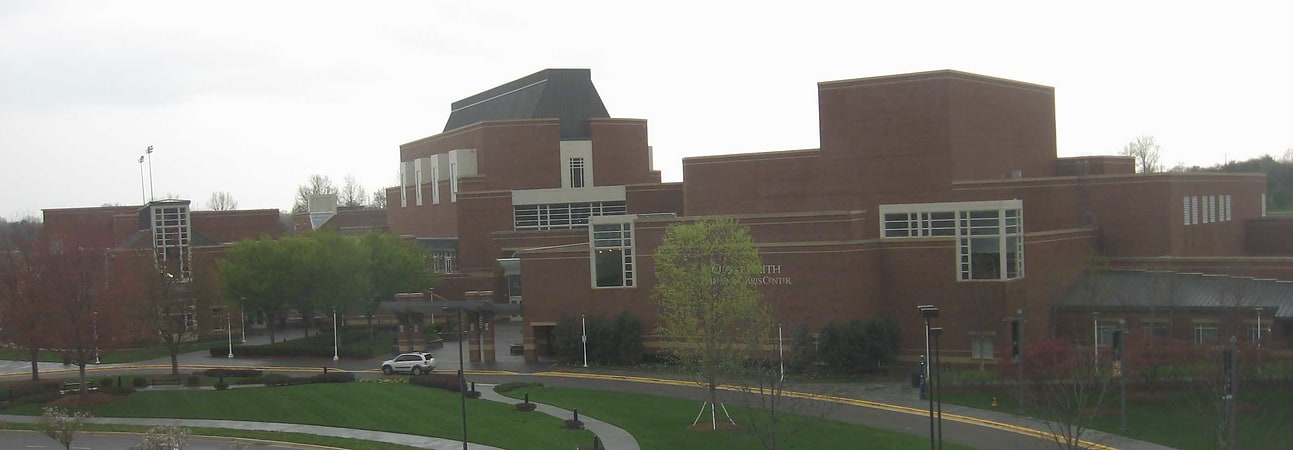
Building complex in College Park, Maryland. The Clarice Smith Performing Arts Center is a performing arts complex on the campus of the University of Maryland, College Park. The 318,000-square-foot facility, which opened in 2001, houses six performance venues; the UM School of Music; and the UMD School of Theatre, Dance, and Performance Studies. It also houses the Michelle Smith Performing Arts Library. The Center operates under the auspices of the University of Maryland College of Arts and Humanities.
The Center presents an annual performance season of music, dance and theatre featuring visiting artists and student/faculty artists from the performing arts academic programs. In 2014, the venue rebranded itself The Clarice. The introduction of this brand was accompanied by a series of mostly-free-of-charge events called the NextNOW Festival near the beginning of the Fall semester. The Center also rents performance and meeting space to community groups.
The building is located on the northern side of the University of Maryland campus, off University Boulevard (MD-193) and Stadium Drive in Prince George’s County, Maryland. It is directly across the street from Capital One Field at Maryland Stadium and the 800-space Stadium Drive parking garage.[4]
Address: University Blvd & Stadium Dr, 20742-0001 College Park (College Park)
Lake Artemesia

Lake in Maryland. Lake Artemesia is a man-made lake in Prince George's County, Maryland, located within the Lake Artemesia Natural Area in College Park and Berwyn Heights. The lake covers an area of 38 acres, and the surrounding natural area is administered by Maryland-National Capital Park and Planning Commission and includes aquatic gardens, fishing piers, and hiker-biker trails.
The lake, located between Indian Creek and Paint Branch, was constructed during the late-1980s completion of the Washington Metro's Green Line, which runs alongside the lake. Sand and gravel were excavated from the site of a smaller lake and the surrounding area to construct the rail beds and parking lots for the College Park–University of Maryland and Greenbelt stations. Metro saved $10 million by sourcing the material locally and in return spent $8 million constructing the lake and natural area to repair the excavation damage. During the construction phase, signs identified the site as "Lake Metro."
The park is named for Artemesia N. Drefs, who donated ten lots to the county for preservation as open space in 1972. The smaller lake that existed on the site prior to the Metro-funded reconstruction was already named Lake Artemesia after Artemesia's mother and grandmother, who shared the same name. Drefs's father, Arthur, surveyed the land for his Lakeland development in the 1890s; according to Drefs, the pre-existing lake was originally used to raise goldfish, but was later stocked with bass.
The 1.35 mile hiker-biker trail around the lake is part of the Anacostia Tributary Trail System and East Coast Greenway.
The site of Lake Artemesia Park was once home to about one third of the Lakeland community, an African-American community which became part of College Park, Maryland in 1945.[5]
Address: Anacostia Tributary Trail System, 20740 Berwyn Heights (College Park)
The Art Gallery

Museum in College Park, Maryland. The University of Maryland Art Gallery is the flagship art museum on the campus of the University of Maryland, College Park. The Gallery is a member of the American Alliance of Museums, Association of Academic Museums and Galleries, and the National Art Education Association.[6]
Address: 3834 Campus Dr, 20742 College Park (College Park)
Greenbelt Park
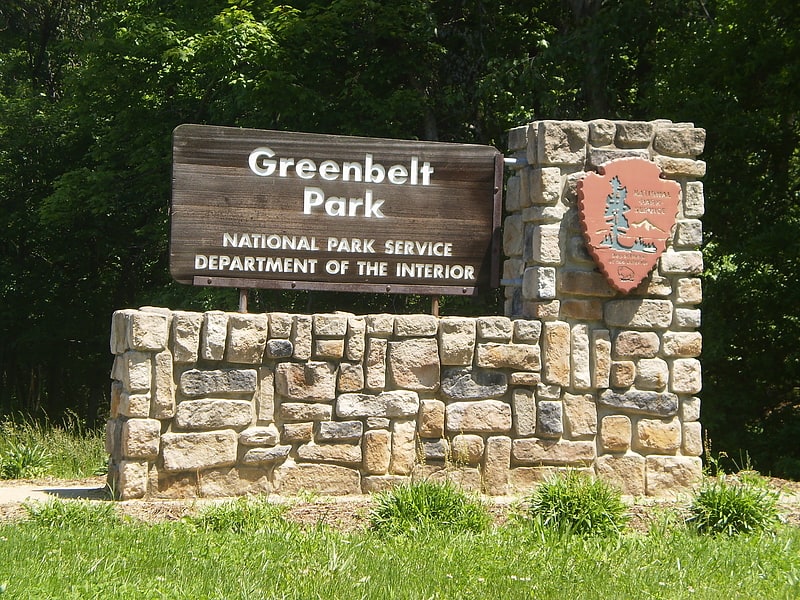
Park in Prince George's County, Maryland. Greenbelt Park is a park in Greenbelt, Maryland, that is managed by the National Park Service. The forested park lies approximately 10 miles northeast of Washington, D.C., and is situated just within the Capital Beltway. The park land was originally intended to form part of the green belt surrounding the city of Greenbelt. The southern portion was assigned to the National Park Service, thus forming the park, while another section became part of the Henry A. Wallace Beltsville Agricultural Research Center.
Recreational facilities include a 5.3 mile (8.5 km) mile hiking and equestrian trail, several shorter nature trails, numerous campsites, and three picnic areas.
The park received its National Park designation in 1950, and was acquired along with the land that would form the Baltimore-Washington Parkway, which divides the park in a roughly north-south direction. Nearly all of the park's facilities are located within the larger western portion (the eastern portion has one fire road).[7]
Adele H. Stamp Student Union
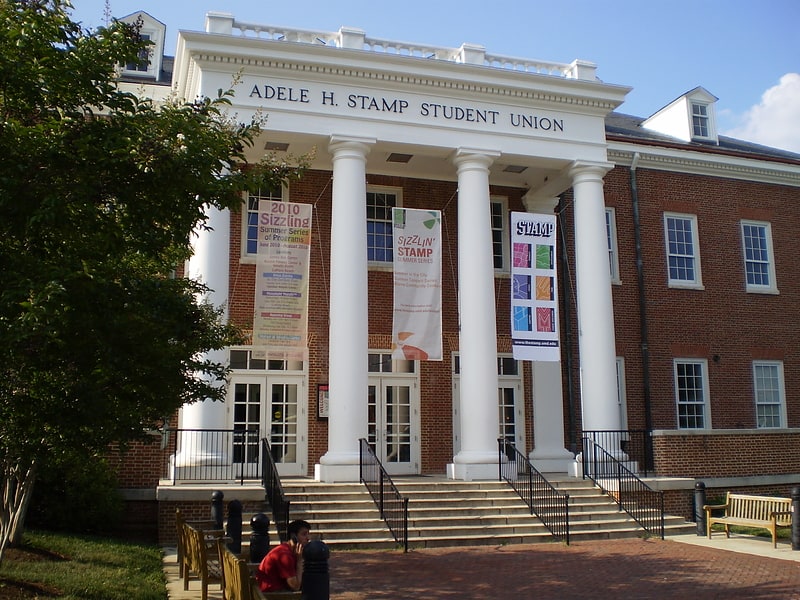
Student union in College Park, Maryland. The Adele H. Stamp Student Union, commonly referred to as "Stamp", is the student activity center on the campus of the University of Maryland, College Park. First constructed in 1954, the building was renamed in 1983 for Adele Hagner Stamp, who served as the university's dean of women from 1920 to 1960. Stamp houses nearly all of the university's student organizations, and is considered the "center of campus life," receiving more than 19,000 visitors daily.[8]
Address: 1 Campus Dr, 20740 College Park (College Park)
The Rossborough Inn

The Rossborough Inn is a historic building facing Baltimore Avenue/United States Route 1 on the eastern edge of the campus of the University of Maryland at College Park. Construction on the building began in 1798 and was completed in 1812, making it the oldest building on campus and the oldest building in the adjoining town of the City of College Park. It is built in the Federal style. The lower wings were added in 1938, as part of extensive renovations. The Rossborough Inn is listed as a historic site by the Maryland-National Capital Park and Planning Commission.
The inn and tavern was constructed by land speculator John Ross, to serve people traveling between Baltimore and Washington D.C. (on the old Washington and Baltimore Turnpike). According to Anne Turkos, the archivist for the University of Maryland Libraries, the name '"Rossborough"' refers to the name of the area the inn was built on in the late 18th Century and early 19th Century, after landowner Richard Ross ("Rossborough" was used interchangeably with "Rossburg" as late as the 1920s). By 1835, financial troubles had doomed the business and the building was being used as a farmhouse by its owner, Charles Benedict Calvert, (1808–1864), whose family owned the nearby Riversdale Plantation. In 1858, Calvert donated the land that the Rossborough building sat on to the Maryland Agricultural College (now University of Maryland at College Park).
The Rossborough Inn was a faculty residence when, in 1864, during the Civil War, Confederate Army General Bradley T. Johnson (of Frederick, Maryland) and his cavalry brigade occupied the university grounds, utilizing the building as his headquarters.
The building has been used for a variety of purposes since. Currently it contains the Office of Undergraduate Admissions, but it has acted as the home of University of Maryland Faculty and Alumni Club and housed a restaurant, "The Carriage House", that served lunch on weekdays.
According to campus lore, the Rossborough Inn is haunted by ghosts of the American Civil War.
Extensive renovations by the university (aided by the federal government) have resulted in a significantly more contemporary appearance than the original. Carved in the keystone above the front door is the head of Silenus, made of a rare Coade stone.[9]
University of Maryland Arboretum & Botanical Garden
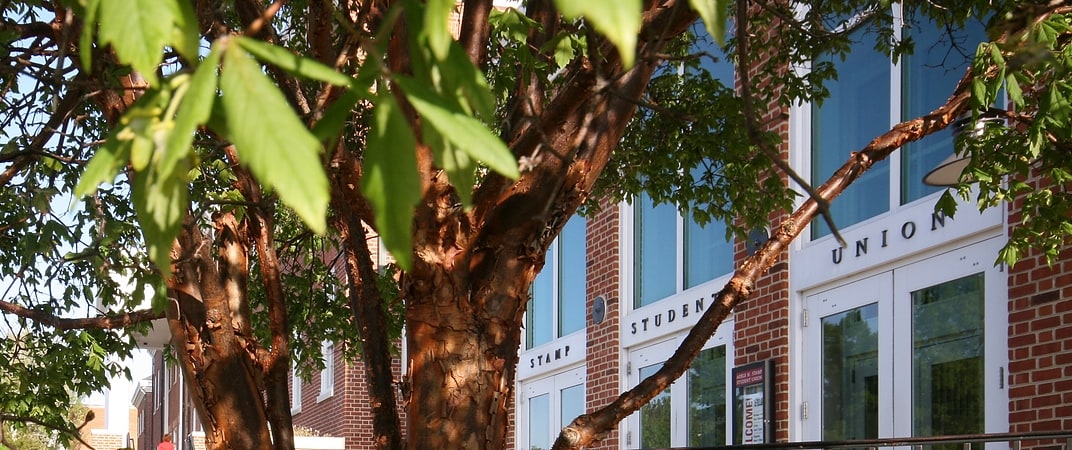
The University of Maryland Arboretum and Botanical Garden is located on the grounds of the University of Maryland - College Park. The Arboretum and Botanical Garden is free to visit and is used as an outdoor classroom for a variety of courses at the University. There is an established Central Campus Tree Walking Tour around McKeldin Mall.[10]
United States National Agricultural Library
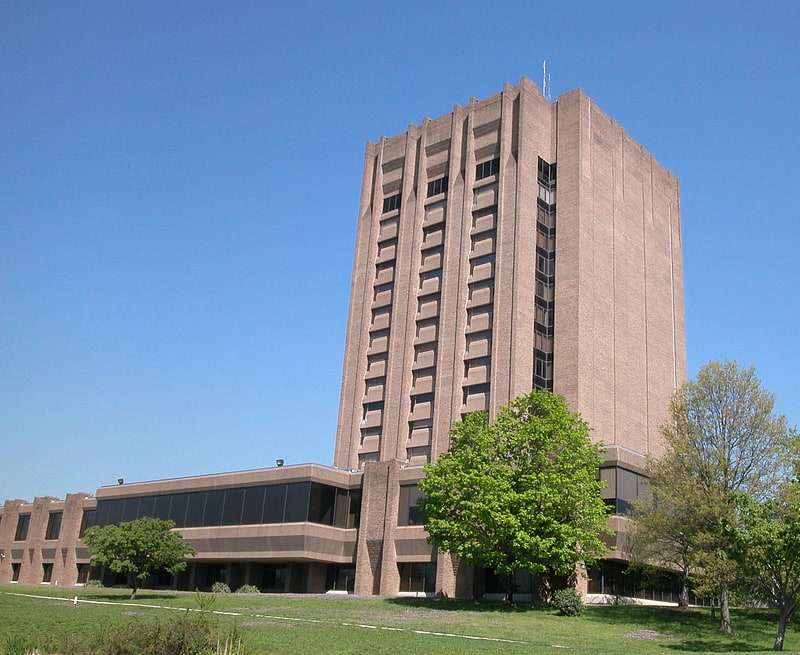
The United States National Agricultural Library is one of the world's largest agricultural research libraries, and serves as a national library of the United States and as the library of the United States Department of Agriculture. Located in Beltsville, Maryland, it is one of five national libraries of the United States. It is also the coordinator for the Agriculture Network Information Center, a national network of state land-grant institutions and coordinator for the U.S. Department of Agriculture field libraries.
NAL was established on May 15, 1862, by the signing of the Organic Act by Abraham Lincoln. It served as a departmental library until 1962, when the Secretary of Agriculture officially designated it as the National Agricultural Library. The first librarian, appointed in 1867, was Aaron B. Grosh, one of the founders of the National Grange of the Order of Patrons of Husbandry.[11]